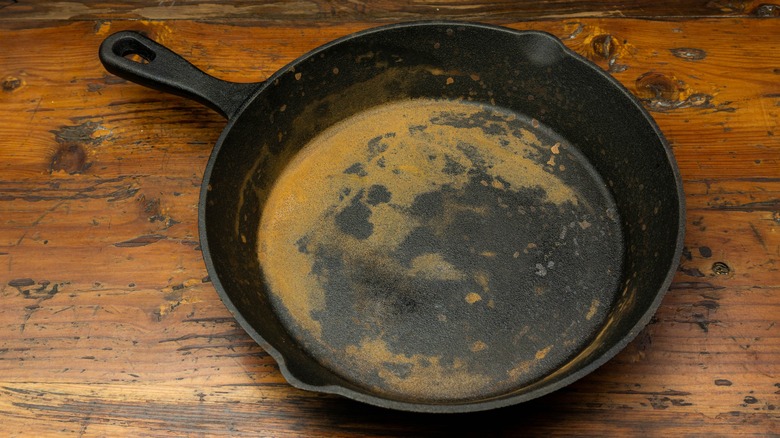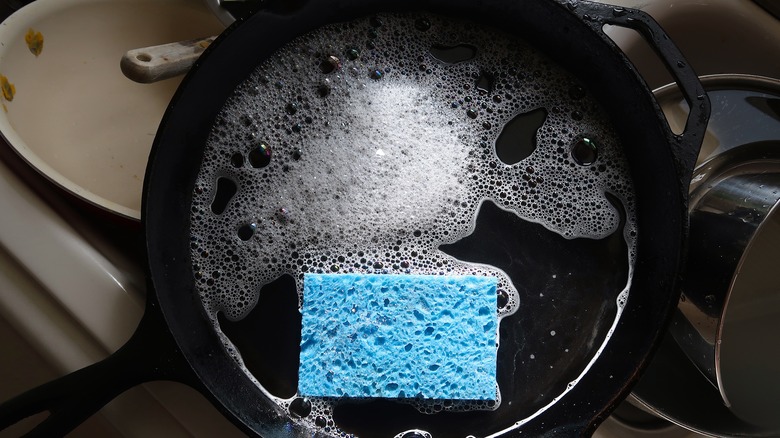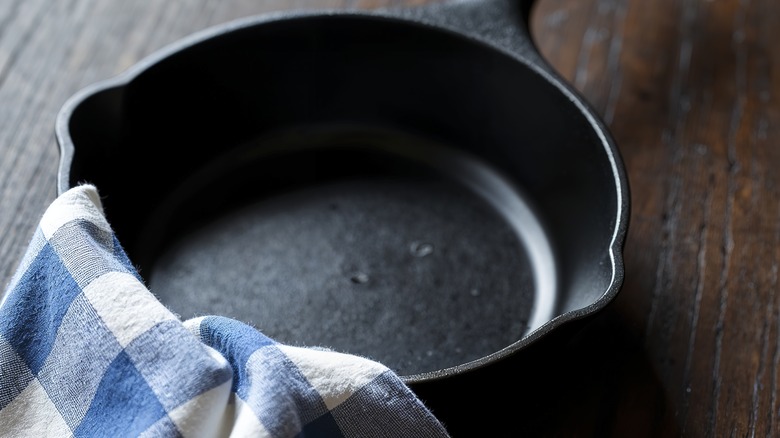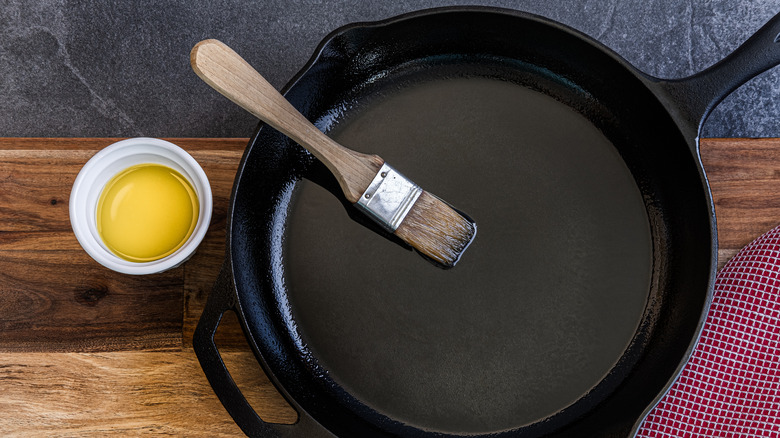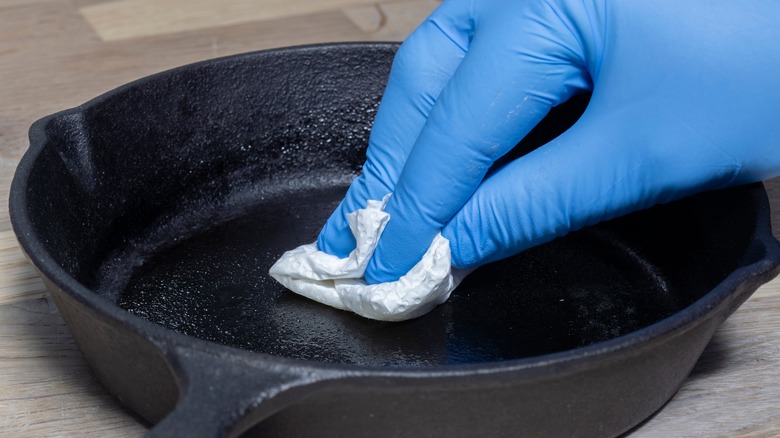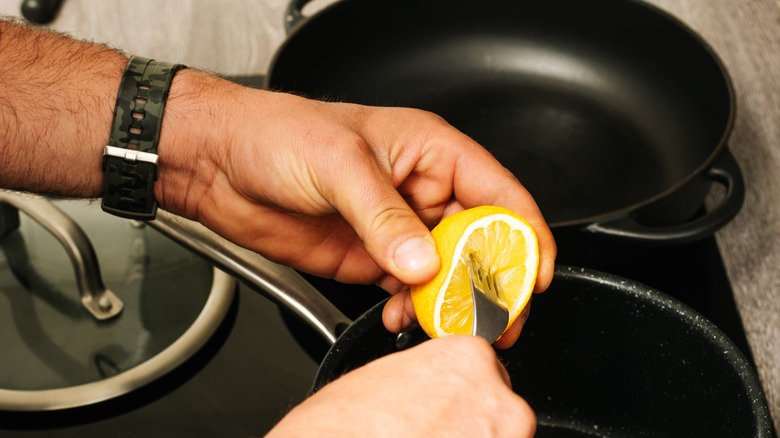5 Ways You're Ruining Your Cast Iron Pans
We may receive a commission on purchases made from links.
Many people had a grandmother who treated her cast-iron skillet like a member of the family — a member of the family that was gently massaged with oil every night and was never allowed to take a bath. If you tried to be helpful and clean it for her ("Look Grandma, I finally got all those stains off of your pan! It's good as new!"), crying commenced and a funeral was held in its honor.
Why all the fuss about a pan? Cast iron is excellent at holding and distributing heat, and cooks food evenly without having to move it around the pan. The dense material can also withstand high temperatures without burning your food. You can place cast iron right on the grill, on the stove, or in the oven without dirtying multiple pans. It is naturally nonstick and easier to clean than other cookware.
Cleaning and caring for cast-iron pans is easier than you might think, but there are some surefire ways to ruin them — one of which is taking Grandma's advice and never washing it. Washing it gently with soap and water, drying it thoroughly, oiling it down, seasoning it a couple times a year, and avoiding acidic foods will make sure your cast-iron skillet lasts a long time. Long enough for you to yell at your grandkids about how to care for it.
Refusing to wash it
One popular myth is that cast iron can never touch soap or it loses its power, like the Biblical hero Samson cutting his hair. But you can — and should — clean your cast iron skillet with some soap and water, for goodness' sake! A little dish soap is necessary for removing bacteria. Without soap, your skillet's hard-earned crust can grow rancid and contaminate all future meals. While you shouldn't hack at your skillet with steel wool, a soft sponge won't destroy your pan's surface.
To clean a cast iron skillet, gently wash with dish soap and a sponge. You can dislodge caked-on food with a scraper, like these durable pan scrapers made by Lodge Cast Iron, specifically for use on cast-iron pans. If the food won't budge, use some olive oil, kosher salt, and a paper towel to scrub it away, or try simmering some water in it for five minutes, using the scraper after it has cooled. Don't let the pan soak in water. It's important to wash, dry, and oil your cast-iron pans promptly, and never place your cast iron pan in the dishwasher.
Not drying it thoroughly
This may shock you, but cast-iron pans are made with — wait for it — iron. When iron reacts with water, it oxidizes, or rusts. To keep your cast-iron skillet from rusting, never leave it wet. That goes for soaking it in water before washing and for not drying it thoroughly enough. Because cast iron is quite porous, water may still linger even if the pan appears dry. The best way to ensure your pan is completely free of moisture is to place it on the stove over low to medium heat for a few minutes.
If your pan does rust, you can remove it using a scouring pad and cold water, or a rust eraser tool from Lodge Cast Iron. Yes, you may lose some seasoning in the process, but rust is much worse for your cast-iron kitchenware, and you can always re-season. After removing the rust, you should wash, dry (with both a dish towel and over the stove to prevent more rust forming), and oil as usual.
Not oiling it after use
You've carefully washed and dried your skillet, but there's still one more step you need to take before placing it back in the cabinet. Using a paper towel or pastry brush, apply a thin layer of oil to the surface. Like adding lotion to your skin post-shower, oiling your pan after washing will keep it from cracking. It also provides protection against rust, allowing moisture to bead on the surface instead of seeping into the pan. This is a quick step you can take after each use and is different from seasoning your skillet, which is only necessary two to three times a year — more on that later.
Choose a flavor-neutral oil like canola oil or vegetable oil, and stay away from lard or anything that could spoil. Sunflower, grapeseed, and flaxseed oils can also be used, but they are more expensive, so you may want to save them for the twice-annual seasoning step. Once your pan has been oiled, you are free to store it in a dry place. Keep it away from the sink or anywhere it could get wet. Try not to stack other pans on top of your cast iron, as they could scratch the surface and remove your oil layer.
Not seasoning it regularly
You've probably heard the term "seasoning" in reference to cast iron, and may think it means salting and peppering your skillet for added flavor. However, it actually refers to baking in a layer of oil. The baked-in oil protects your pan from rusting, creates a natural nonstick layer for cooking, and yes, adds some flavor to your food.
To season a cast iron skillet, add oil to a thin cloth or paper towel and oil the entire surface, inside and out. Use a clean paper towel to wipe away excess oil, leaving a shine on your pan but no visible drips. Place your pan upside-down on a parchment-lined baking sheet in a hot oven (around 400 degrees Fahrenheit) for one hour. You can use a variety of oils to season your pan, but pay attention to the smoke point of the oil and adjust the oven temperature accordingly (many cast iron skillet brands sell their own seasoning spray that come with detailed instructions).
You should season your pan around twice a year, or more if you use your pan frequently. If you notice food is starting to stick to your pan, it is time to re-season.
Cooking acidic foods
It's okay to cook acidic foods like tomatoes, citrus, and wine in cast iron, but only if it is very well-seasoned. While most cast-iron pans come pre-seasoned, they still aren't ready to tackle acids until a few more rounds of seasoning have taken place. Acids can strip a pan of its seasoning layer and give your food a metallic taste, which is why it's important to have plenty of layers built up. There are some pans that come "triple seasoned" and are ready to cook acids right out of the box, but check the manufacturer's instructions before doing so.
The amount of acidic ingredients and the length of time they remain on your pan are factors to consider. For instance, a quick lemon-butter sauce or deglazing the pan with a splash of wine should be completely fine, while simmering tomatoes all day is not. Don't leave acidic foods in your cast-iron cookware for longer than 45 minutes, and clean it immediately once cooled.
